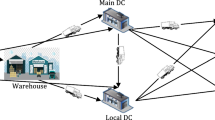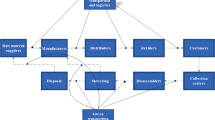Abstract
Because of the energy shortage and energy price rise, energy efficiency becomes a worldwide hot spot problem. It is not only a problem about cost reduction, but also a great contribute to the environmental protection. However, the energy efficiency was always ignored in the past decades. In order to gain more benefit and become more competitive in the market, energy efficiency should be considered as an essential factor in early planning phase. To overcome these problems, a new approach, which introduces energy efficiency as a key criterion into the planning process, is presented in this article. An energy recovery network is built according to the analysis of process and product demands. Afterwards the energy loss of the whole system, transport performance and space demand are simultaneously taken into account with the purpose of finding good facility planning from both energy and economic aspects. Finally, a practical expanding case is used to validate the correctness and effectiveness of the proposed approach.
Similar content being viewed by others
References
Abyaneh, S. H., Zandieh, M. (2011) Bi-objective hybrid flow shop scheduling with sequence-dependent setup times and limited buffers. The International Journal of Advanced Manufacturing Technology. doi:10.1007/s0017001133685.
Agarwal A., Guptam S. K. (2008) Multiobjective optimal design of heat exchanger nerworks using new adaptations of the elitist nondominated sorting genetic algorithm, NSGA- II. Industrial & Engineering Chemistry Research 47(10): 3489–3501
Ahmad Z., Rahmani K., Souza R. M. D. (2010) Applications of genetic algorithms in process planning: tool sequence selection for 2.5-axis pocket machining. Journal of Intelligent Manufacturing 21: 461–470
Aiello G., Enea M., Galante G. (2006) A multi-objective approach to facility layout problem by genetic search algorithm and Electre method. Robotics and Computer-Integrated Manufacturing 22: 447–455
Balakrishnan J., Cheng C. H. (2007) Multi-period planning and uncertainty issues in cellular manufacturing: A review and future directions. European Journal of Operational Research 177: 281–309
Bandyopadhyay, S.,& Bhattacharya, R. (2011). Applying modified NSGA-II for bi-objective supply chain problem. Journal of Intelligent Manufacturing. doi:10.1007/s1084501106172.
Berrichi A., Amodeo L., Yalaoui F., Châtelet E., Mezghiche M. (2009) Bi-objective optimization algorithms for joint production and maintenance scheduling: application to the parallel machine problem. Journal of Intelligent Manufacturing 20: 389–400
Cai, M., & Kagawa, T. (2001). Design and application of air power meter in compressed air systems. In Second international symposium on environmentally conscious design and inverse manufacturing (pp. 208–212). 2001 Japan, Dec 11–15.
Cheng F. Q., Ye F. F., Yang J. G. (2009) Multi-objective optimization of collaborative manufacturing chain with time-sequence constraints. The International Journal of Advanced Manufacturing Technology 40: 1024–1032
Cheshmehgaz, H. R., Desa, M. I., & Wibowo, A. (2011). A flexible three-level logistic network design considering cost and time criteria with a multi-objective evolutionary algorithm. Journal of Intelligent Manufacturing. doi:10.1007/s1084501105847.
Deb K., Pratap A., Agarwal S., Meyarivan T. (2002) A fast and elitist multiobjective genetic algorithm: NSGA-II. IEEE Transactions on Evolutionary Computation 6: 182–197
Dolan W. B., Cummings P. T., LeVan M. D. (1990) Process optimization via simulated annealing for heat exchanger network design. Computer and Chemical Engineering 14: 1039–1050
Duzanec, D., & Kovacic, Z. (2009). Performance analysis-based GA parameter selection and increase of μGA accuracy by gradual contraction of solution space. In IEEE International Conference on Industrial Technology. Gippsland, Australia, February 10–13. doi:10.1109/ICIT.2009.4939483.
Dwijayanti, K.,& Dawal, S. Z. (2010). A Proposed study on facility planning and design in manufacturing process. In Proceeding of the international multiconference of engineers and computer scientists 2010 (pp. 1640–1645). Hong Kong, March 17–19.
Energy agent NRW. (2011). Energiekosten und leckagen: Das Druckluftnetz- ein Energiefresser im Betrieb. http://www.energieagentur.nrw.de/_database/_data/datainfopool/DruckluftBroschuere.pdf. Accessed 25 July 2011.
Frausto-Hernández S., Rico-Ramírez V., Jimérrez A., Jimérrez A. (2003) MINLP synthesis of heat exchanger networks considering pressure drop effects. Computers & Chemical Engineering 27: 1143–1152
Geldermann J., Treitz M., Rentz O. (2006) Integrated technique assessment based on the pinch analysis approach for the design of production networks. European Journal of Operational Research 171(3): 1020–1032
Geldermann J., Treitz M., Schollenberger H., Ludwig J., Rentz O. (2007) Integrated process design for the inter-company plant layout planning of dynamic mass flow networks. Universitätsverlag Karlsruhe, Kalrsruhe
Government of Alberta Energy. (2011). Alberta gas reference price History. http://www.energy.alberta.ca/NaturalGas/1322.asp. Accessed 21 July 2011.
Heragu S. S., Kusiak A. (1991) Efficient models for the facility layout problem. European Journal of Operational Research 53: 1–13
Ishibuchi H., Murata T. (1998) A multi-objective genetic local search algorithm and its application to flowshop scheduling. IEEE Transaction on Systems, Man, and Cybernetics—Part C: Applications and Reviews 28: 392–403
Ishibuchi, H., & Narukawa, K. (2004). Performance evaluation of simple multiobjective genetic local search algorithms on multiobjective 0/1 knapsack problems. In IEEE Congress on evolutionary computation (pp. 441–448). Portland, USA, June 19–23.
Kannan S., Baskar S., McCalley J. D., Murugan P. (2009) Application of NSGA-II algorithm to generation expansion planning. IEEE Transactions on Power Systems 24: 454–461
Kemp I. C. (2007) Pinch analysis and process integration: A user guide on process integration for the efficient use of energy. Butterworth-Heinemann, Oxford
Krenn, C., Fresner, J., & Meixner, E. (2008). Energieeffizienzsteigerung in Unternehmen der stahlverarbeitenden Industrie durch Abwärmenutzung im Niedertemperaturbereich. In: The 10. Symposium Energieinnovation. Austria: Graz.
Moya J. A., Pardo N., Mercier A. (2011) The potential for improvements in energy efficiency and co 2 emissions in the EU27 cement industry and the relationship with the capital budgeting decision criteria. Journal of Cleaner Production 19: 1207–1215
Müller E., Engelmann J., Löffler T. H., Strauch J. (2009) Energieeffiziente Fabriken planen und betreiben. Springer, Berlin
Ponce-Ortega J. M., Serna- González M., Jiménez-Gutiérrez A. (2007) Heat exchanger network synthesis including detailed heat exchanger design using genetic algorithms. Industrial & Engineering Chemistry Research 46: 8767–8780
Siriwardene N.R., Perera B.J.C. (2006) Selection of genetic algorithm operators for urban drainage model parameter optimization. Mathematical and Computer Modelling, 44: 415–429
Syarif A., Gen M. (2003) Solving exclusionary side constrained transportation problem by using a hybrid spanning tree-based genetic algorithm. Journal of Intelligent Manufacturing 14: 389–399
Van Veldhuizen, D. A., & Lamont, G. B. (1998). Evolutionary computation and convergence to a pareto front. In Proceedings of the 1998 Genetic Programming Conference (pp. 221–228). CA: Stanford University.
Wang D. Y., Wang L. Y. (2005) The application of genetic algorithms in facility layout. Computer Engineering and Applications 14: 190–192
Wu, G. Z., Li, D. Y., Qi, H. B., & Li, D. (2010). Analysis on thermal calculation model and influencing factors of steam pipeline. In 2010 International conference on intelligent system design and engineering application (pp. 314–317). Chang Sha, China.
Yalcinoz, T., Altun, H., & Uzam, M. (2001) Economic dispatch solution using a genetic algorithm based on arithmetic crossover. In 2001 IEEE porto power tech conference. doi:10.1109/PTC.2001.964734.
Yee T. F., Grossmann I. E. (1990) Simultaneous optimization models for heat integration-II. Heat exchanger network synthesis. Computers and Chemical Engineering 14: 1165–1184
Ying S. L., Pu Z. Y., Jie W. Y. (2006) Analysis and improve on system lose to process of compressed air transport. Coal Mine Machinery 27: 163–165
Zhao X. C., Gao X. S., Hu Z. C. (2007) Evolutionary programming based on non-uniform mutation. Applied Mathematics and Computation 192(1): 1–11
Author information
Authors and Affiliations
Corresponding author
Rights and permissions
About this article
Cite this article
Yang, L., Deuse, J. & Jiang, P. Multi-objective optimization of facility planning for energy intensive companies. J Intell Manuf 24, 1095–1109 (2013). https://doi.org/10.1007/s10845-012-0637-6
Received:
Accepted:
Published:
Issue Date:
DOI: https://doi.org/10.1007/s10845-012-0637-6




